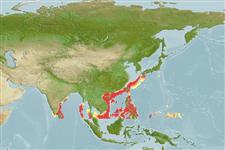Environment: milieu / climate zone / Tiefenbereich / distribution range
Ökologie
seewasser riff-verbunden; tiefenbereich 10 - 297 m (Ref. 90102). Tropical; 32°N - 6°N, 30°E - 155°E
Indo-West Pacific: South Africa (off Durban) east to southern Japan, the Caroline Islands, and eastern Australia.
Size / Gewicht / Alter
Geschlechtsreife: Lm ? range ? - ? cm
Max length : 23.0 cm TL Männchen/unbestimmt; (Ref. 4313)
Rückenflossenstacheln (insgesamt) : 12; Rückenflossenweichstrahlen (insgesamt) : 9; Afterflossenstacheln: 3; Afterflossenweichstrahlen: 5. Highly variable in color and in appendages in relation to habitat. Covered with appendages on algae reefs, but plain when deep with sponges (Ref. 48635). Body highly compressed and covered with weed-like tassels (Ref. 37816).
Body shape (shape guide): short and / or deep; Cross section: compressed.
Found in rich soft-bottom habitats in current prone channels (Ref. 48635); also in rocky or coralline habitats near algae where it camouflages itself. Hunts prey at night like other species of scorpaenids, feeding on fish and small invertebrates. Solitary among corals, rocks and weeds (Ref 90102).
Life cycle and mating behavior
Geschlechtsreife | Fortpflanzung | Ablaichen | Eier | Fecundity | Larven
Myers, R.F., 1991. Micronesian reef fishes. Second Ed. Coral Graphics, Barrigada, Guam. 298 p. (Ref. 1602)
IUCN Rote Liste Status (Ref. 130435: Version 2025-1)
Nutzung durch Menschen
Fischereien: nicht kommerziell; Aquarium: Kommerziell
Tools
Zusatzinformationen
Download XML
Internet Quellen
Estimates based on models
Preferred temperature (Ref.
123201): 17.5 - 27.2, mean 21 °C (based on 186 cells).
Phylogenetic diversity index (Ref.
82804): PD
50 = 0.5156 [Uniqueness, from 0.5 = low to 2.0 = high].
Bayesian length-weight: a=0.01778 (0.00689 - 0.04588), b=3.04 (2.82 - 3.26), in cm total length, based on LWR estimates for this (Sub)family-body shape (Ref.
93245).
Trophic level (Ref.
69278): 4.0 ±0.60 se; based on food items.
Widerstandsfähigkeit (Ref.
120179): mittel, Verdopplung der Population dauert 1,4 - 4,4 Jahre. (Preliminary K or Fecundity.).
Fishing Vulnerability (Ref.
59153): Low vulnerability (13 of 100).
🛈
